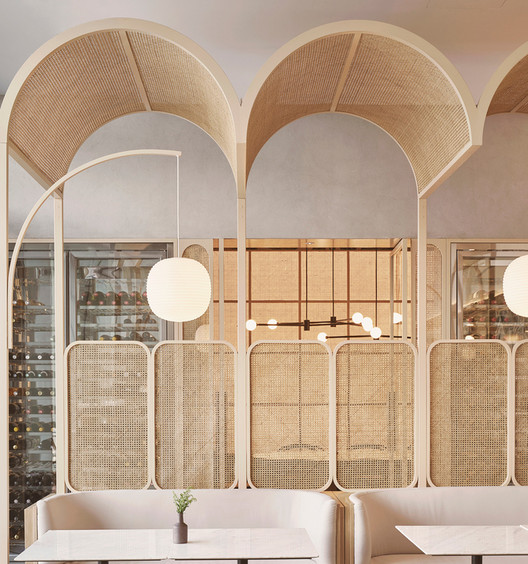
Over the past couple of years, many designers have voiced their commitment to ethical and ecological sourcing, resorting to frugal designs through local materials, traditional techniques, and equitable architecture. Having this approach in mind, many found inspiration in their cultural heritage, reimagining ancient designs in contemporary contexts.
When thinking of recycled design trends, we can't overlook one of the most well-known and popular materials that was shared by nations all around the globe over the span of 100 years; on balconies, outdoor patios, gardens, and indoor living spaces: rattan. It is estimated that almost seven hundred million people worldwide use rattan, with many countries presenting it as an integral part of their cultures. In this article, we look at how architects and designers integrated rattan in their designs and found numerous ways to make the best out of Southeast Asia's popular local material.
It is believed that rattan canes are one of the world's most valuable non-timber forest products. The plant belongs to the palm trees family (Calamoideae), and varies between 1 to 2 inches in diameter and grows up to 200 to 500 feet. After making sure the stem is mature enough, it is cautiously cut and detached from its crown. After being detached, the stem is peeled and cut into canes of various lengths. In terms of collection and processing, it is easier to harvest and transport than timber, and grows faster than trees.

Regardless of its popularity, there have been many concerns with the material’s recent exploitation; its high demand has led to risking the plant’s sustainability. Cutting the plant’s stems prematurely prevents them from sprouting again, which forces producers to use synthetic materials instead. In addition, deforestation in the materials countries of origin has led to a shortage of rattan supply.
Rattan is a lightweight, flexible, durable, and aesthetic material that makes it easy to manipulate. It is often confused with wicker, a material also extensively used in furniture, however they are completely different. Wicker is a type of weave that is said to have originated in ancient Egypt, whereas rattan is a naturally-growing vine-like plant with origins in South East Asia, Australia, and Africa. Most of the world’s Rattan supply is produced by the Philippines, Malaysia, and Sri Lanka, and is distributed to countries all over the world.

In the early 20th century, the United States began importing Victorian-style rattan furniture pieces from the Philippines, and using them in terraces and gardens. This merge introduced a new design style known as “Tropical Deco”, which then became a popular trend across the world. In recent years, interior and furniture designers have used rattan in chairs, tables, cabinets, lighting, and partitions, combining traditional local materials with contemporary designs. The material has similar features to bamboo, especially when it comes to interior fit-outs and furniture, making it a very 'timeless' and versatile product with several design options that offer ventilation, natural lighting, and privacy.
Partitions & Screens
0219 GHTK Interior Office / iplus Architecture

Screen Pavilion / Ray&Emilio Studio

JOHN ANTHONY / Linehouse

A Gentle Abode / nitton architects

Ceilings
Ma's Kitchen / Chengdu Hummingbird Design Consultant Co., Ltd.

Odori Hotel / Nimara Architects

INBAR Garden Pavilion / Studio Cardenas Conscious Design

Furniture
City Oasis Apartments / K.A Studio

Dream House / JINGU PHOENIX

Light & Shadow / Studio 10
.jpg?1629028242)
Cabinets
The Modular Lilong / LUKSTUDIO

H Dining / PHTAA Living Design

LAMAISON Hotel & Guesthouse / CBAG.Studio Architects

Rattan in Concrete Jungle Apartment / Absence from Island

Lighting
Light & Shadow / Studio 10

Pizza 4P’s Restaurant Landmark 72 / ODDO architects

Facade
Nearly Zero Energy Building of the Gui'an Innovation Park / SUP Atelier

Cilandak Stackhouse / Atelier Riri

Sources
- Production and Processing of Rattan by Emilienne Lionelle Ngo Samnick
- Rattan: Current research issues and prospects for conservation and sustainable development
Find more projects utilizing rattan in their interior and furniture design in this My ArchDaily folder created by the author.
This article is part of the ArchDaily Topic: Local Materials. Every month we explore a topic in-depth through articles, interviews, news, and projects. Learn more about our monthly topics. As always, at ArchDaily we welcome the contributions of our readers; if you want to submit an article or project, contact us.
This article is part of an ArchDaily series that explores features of interior architecture, from our own database of projects. Every month, we will highlight how architects and designers are utilizing new elements, new characteristics and new signatures in interior spaces around the world. As always, at ArchDaily, we highly appreciate the input of our readers. If you think we should mention specific ideas, please submit your suggestions.


















.jpg?1629028242)




